Frontline report: Cluster munitions prove effective in halting Russian advance near Kostiantynivka
Ukrainian defenders successfully repel multiple Russian attacks near Donetsk's Kostiantynivka using mines, cluster munitions, and drones. Despite new Russian tactics of splitting assault units, Ukrainian forces inflict heavy losses, though gradual Russian advances continue through attrition.
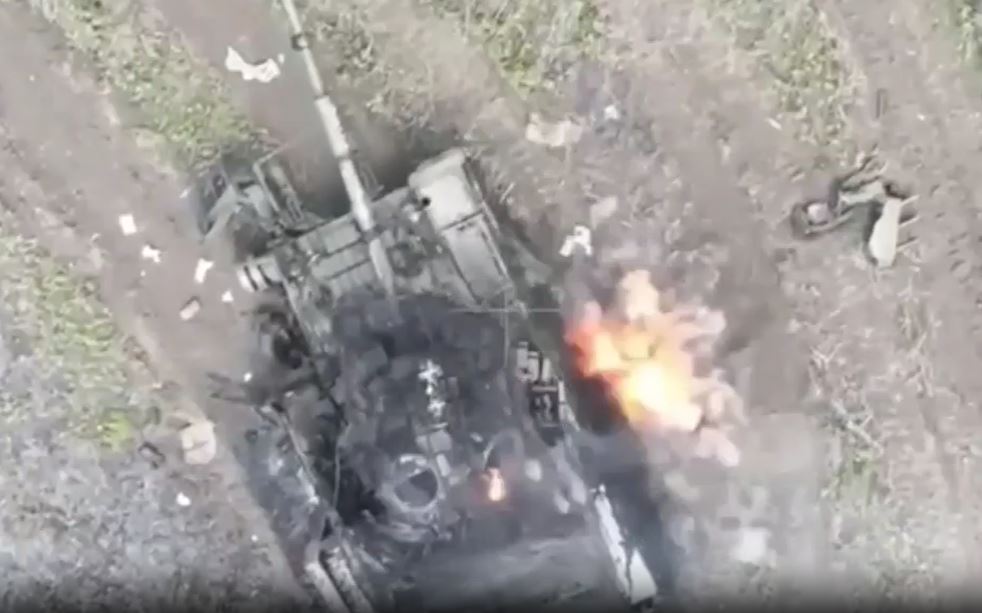

13 August 2024.
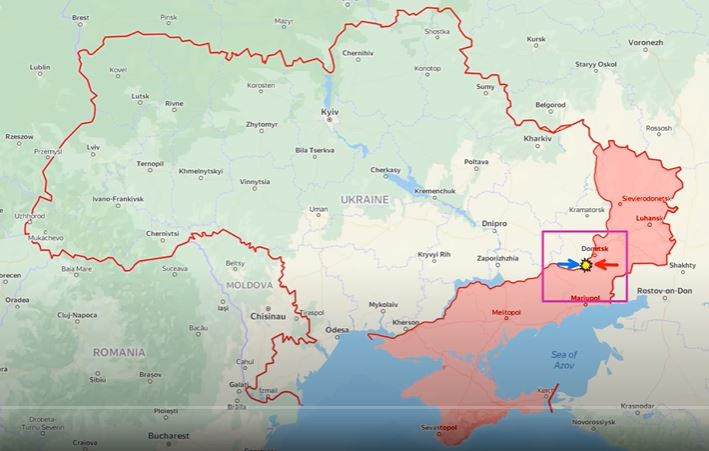
Today, there is a lot of news from the Kurakhove direction.
Here, the Russians conducted a miscalculated attack from the north of Kostiantynivka aimed at overstretching the Ukrainian defense in and around the village. Even though this attempt was unsuccessful it was almost immediately followed up by several highly attritional waves of mechanized assaults from Novomykhailivka and from the south which tried to exploit the momentum before the Ukrainians were able to further fortify their positions.
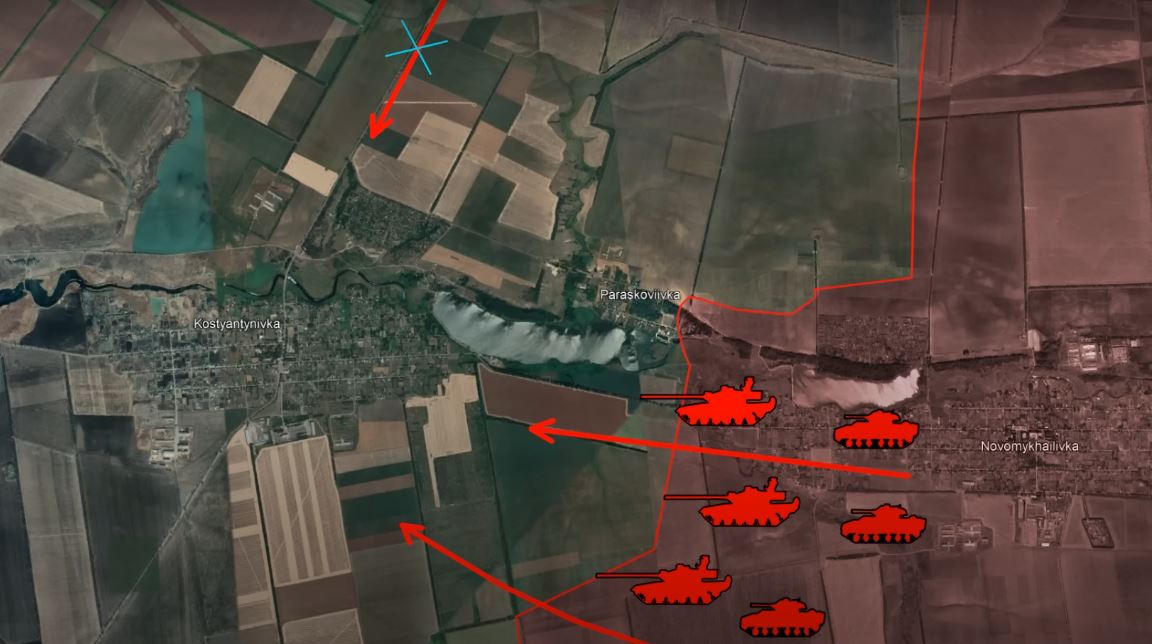
Russian commanders decided that their powerful push from the north should have depleted the Ukrainian defense capabilities at least to a certain extent, so they switched back to their previous tactic of sending mechanized groups consisting of several armored vehicles each. Russians evaluated the potential routes and decided that given the threat of minefields, taking the roads that they used in the preceding attacks was less risky than trying something new to achieve a tactical surprise, so they launched their assault just to the south of the small lakes between Kostiantynivka and Novomykhailivka.
Geolocated footage released by Ukrainian drone operators captures a powerful Russian assault group, consisting of at least 10 armored vehicles, advancing rapidly towards Kostiantynivka through open fields. During earlier probing attacks, the Russians analyzed the average response time of Ukrainian forces and used this intelligence to split their assault units into multiple parts just before the anticipated Ukrainian counterstrikes.
This tactic proved effective, significantly improving the Russians’ chances of crossing the field with reduced combat losses. Each vehicle that manages to reach the designated landing zone and deploy its troops immediately increases the Russians’ chances of establishing a foothold in the first houses, from which they could attempt to capture the entire settlement. 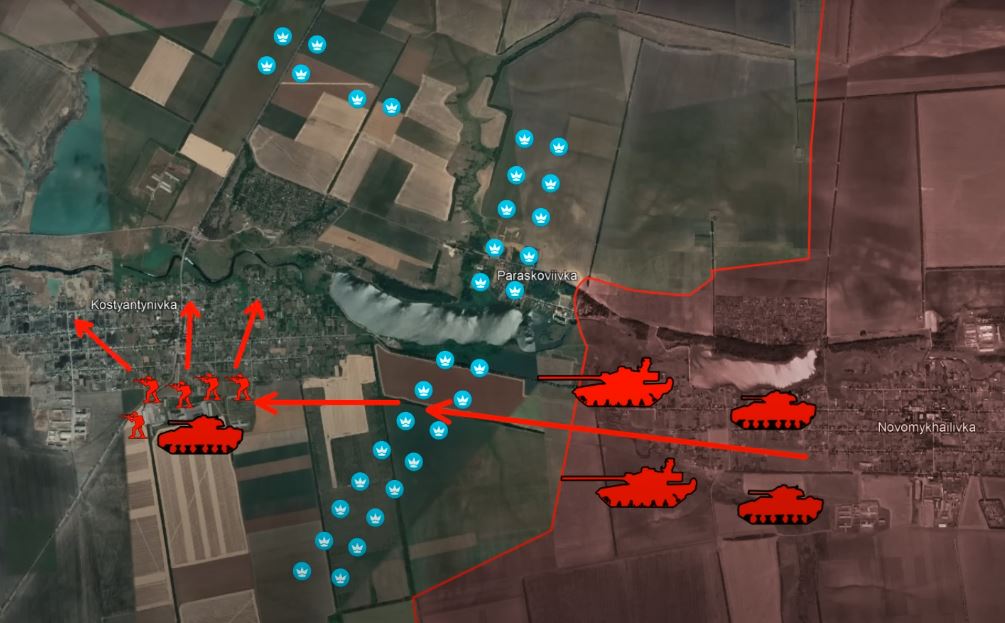 However, despite using familiar paths into the village, the footage reveals that several armored vehicles struck mines, which either destroyed or immobilized them. In both scenarios, surviving crew members were subsequently targeted by Ukrainian forces with grenades dropped from drones. This situation underscores the crucial yet perilous work of Ukrainian soldiers in creating and maintaining extensive networks of minefields, which require constant renewal after each mechanized assault.
However, despite using familiar paths into the village, the footage reveals that several armored vehicles struck mines, which either destroyed or immobilized them. In both scenarios, surviving crew members were subsequently targeted by Ukrainian forces with grenades dropped from drones. This situation underscores the crucial yet perilous work of Ukrainian soldiers in creating and maintaining extensive networks of minefields, which require constant renewal after each mechanized assault.
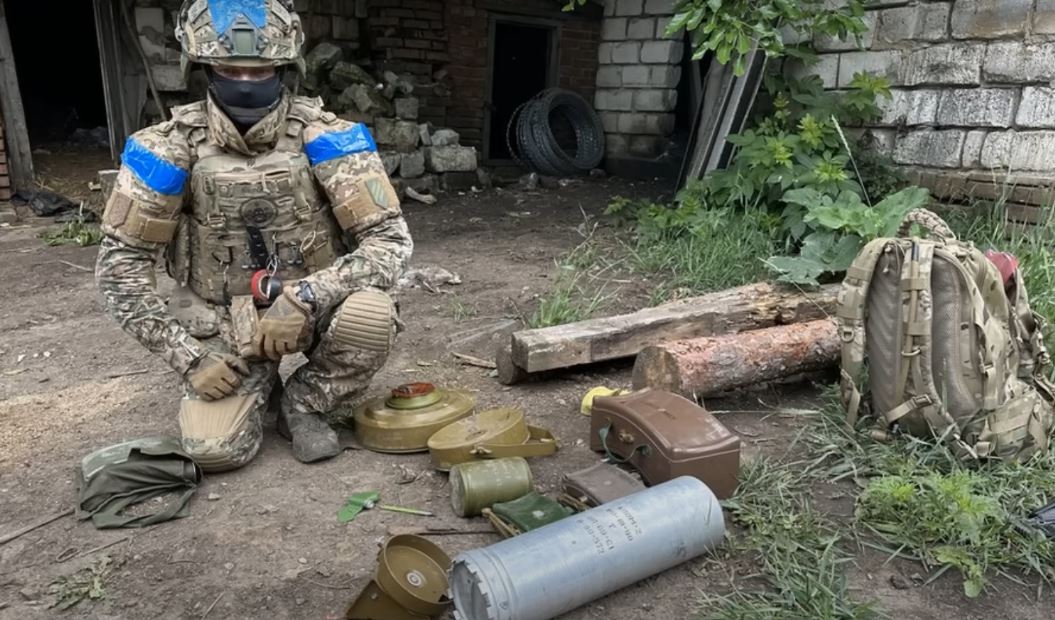
The second most crucial element in the Ukrainian defense strategy for this operation is the deployment of artillery shells equipped with cluster munitions. Multiple geolocated videos from this engagement vividly demonstrate the devastating effectiveness of these munitions, which swiftly neutralize Russian heavy equipment and personnel.
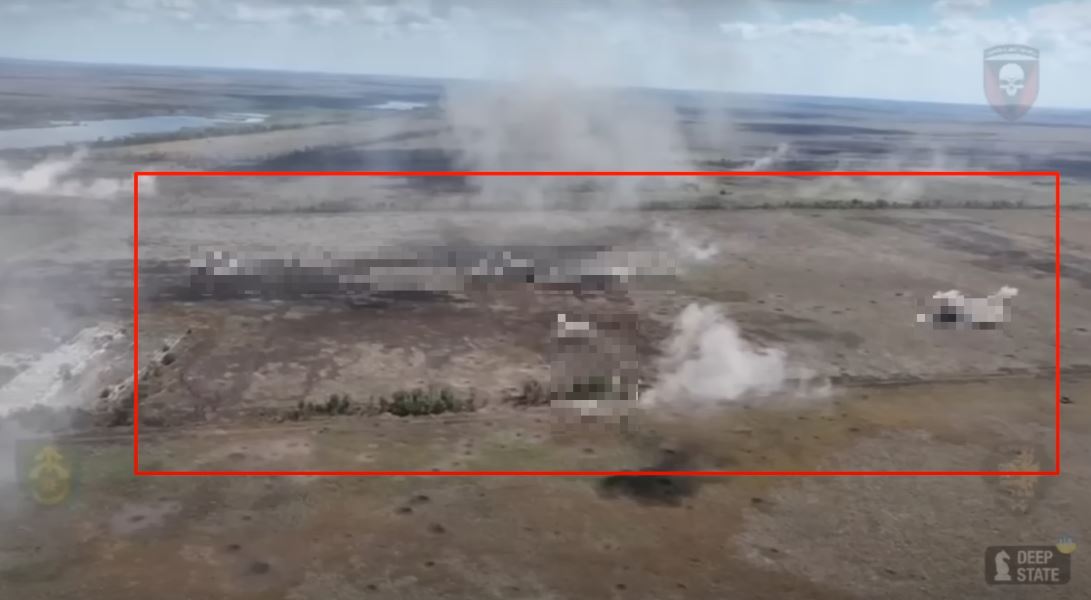
The visual evidence also suggests that the current influx of Western military aid has significantly improved the Ukrainians’ ability to engage the enemy without the need to conserve ammunition — a stark contrast to several months ago when, for instance, the fall of Avdiivka into Russian hands was partly due to a shortage of artillery shells and air defense resources. This availability of munitions has enabled the Ukrainians to counter the new Russian tactic of splitting their units during assaults, allowing them to inflict critical damage on the enemy forces while they are in motion.
The third Ukrainian countermeasure is the usage of kamikaze drones. Footage from the area shows dozens of examples of how Ukrainian FPV drones finish off already damaged Russian tanks, BMPs, and MTLBs. Even though the fields around Kostiantynivka are open terrain and hardly provide any cover, the alarming rate of losses of armored vehicles put pressure on Russian commanders to send their troops to rescue damaged vehicles and try to pull them out to the rear for repair. In most cases, these missions quickly become suicidal as the Ukrainians are constantly on the lookout and generally prefer to destroy such vehicles and not give any chance to the Russians to further use them.
Despite witnessing many of their units being destroyed before even reaching the village, the Russian officers in charge of this operation persisted in sending wave after wave of new groups, hoping that at least one would make it to the houses on the outskirts.
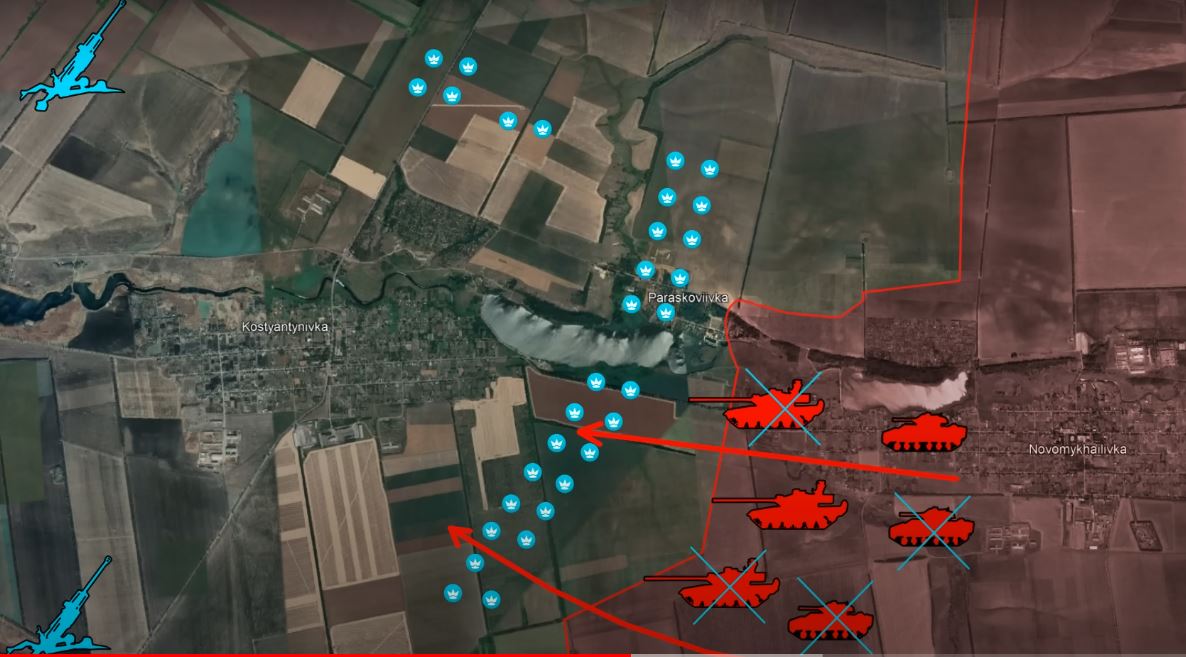
Their persistence eventually paid off, as evidenced by a video released by the Ukrainian 79th Air Assault Brigade, which shows two Russian MTLB vehicles managing to reach the first block of destroyed houses under relentless Ukrainian fire. The troops quickly disembarked and scrambled for cover. Notably, these two armored vehicles were outfitted with large metal plates on top, presumably to offer additional protection. However, as the video reveals, this added armor proved insufficient.

Despite attempts to retreat, the vehicles were swiftly neutralized. The scattered Russian soldiers are seen desperately trying to take shelter beneath already destroyed tanks and in the rubble of the houses, but their efforts are in vain due to the precise and effective targeting by Ukrainian drone operators. All uncensored footage from these Russian attacks can be found on Reporting From Ukraine’s Telegram channel. Overall, the Ukrainians successfully halted the enemy offensive in this sector, effectively countering the new Russian tactic of splitting units during assaults. This success was largely due to the ample supply of munitions available to the defenders.
Despite the ongoing heavy battles that have raged for weeks, with the Russian high command relentlessly sending wave after wave without significant pauses, the Ukrainian minefields are gradually becoming less dense as no defense strategy can remain flawless indefinitely. This leads to the Russian troops getting meter after meter closer, allowing them to generate incremental gains.
However, these small steps forward are achieved through the approach of high attrition and the inevitable operational exhaustion is just a matter of time, which will be followed up by a slowdown, and these slowdowns allow Ukrainians to create new fortifications, annihilating any Russian chance of achieving an operational breakthrough and success, like Ukrainians recently managed to achieve in the Kursk direction.
In our regular frontline report, we pair up with the military blogger Reporting from Ukraine to keep you informed about what is happening on the battlefield in the Russo-Ukrainian war.
You could close this page. Or you could join our community and help us produce more materials like this.
We keep our reporting open and accessible to everyone because we believe in the power of free information. This is why our small, cost-effective team depends on the support of readers like you to bring deliver timely news, quality analysis, and on-the-ground reports about Russia's war against Ukraine and Ukraine's struggle to build a democratic society.
A little bit goes a long way: for as little as the cost of one cup of coffee a month, you can help build bridges between Ukraine and the rest of the world, plus become a co-creator and vote for topics we should cover next. Become a patron or see other ways to support.


